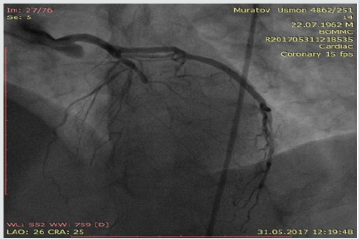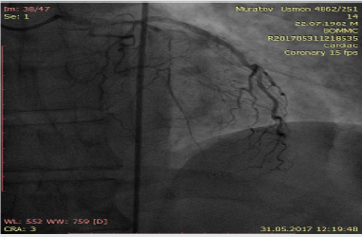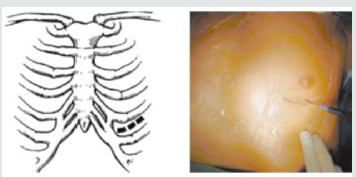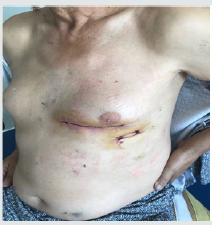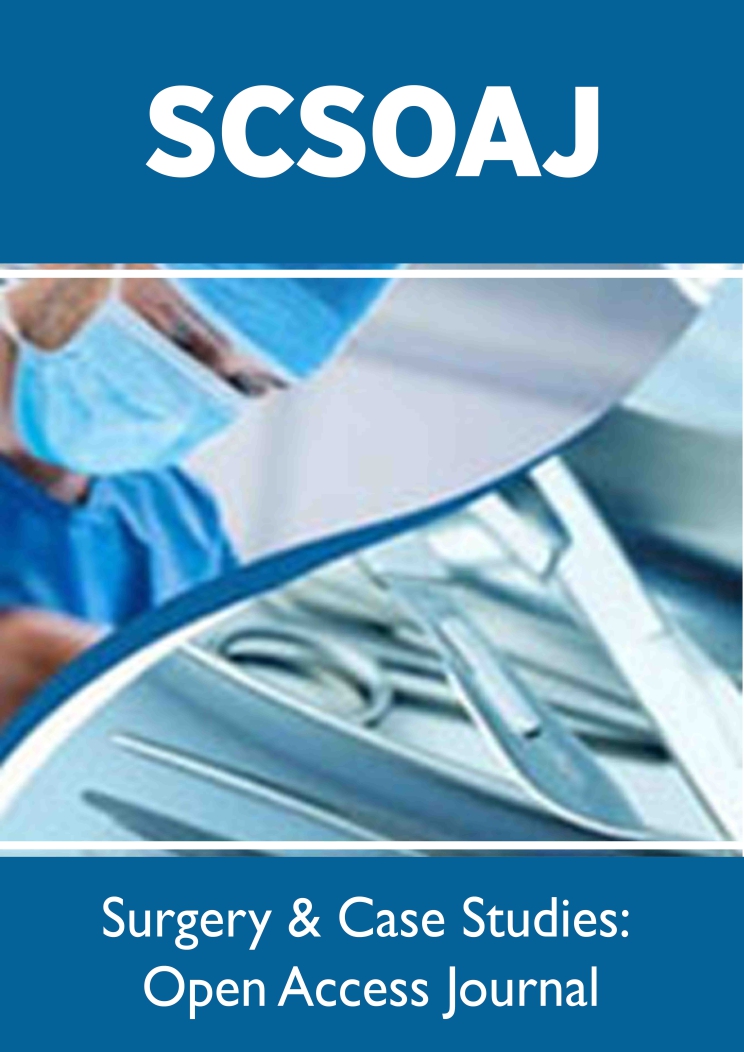
Lupine Publishers Group
Lupine Publishers
Menu
ISSN: 2643-6760
Review Article(ISSN: 2643-6760) 
Mammarokoronarny Shunting on the Working Heart by the “Midcab» Method and Gene Status: The First Experience in Uzbekistan Volume 2 - Issue 2
Muradov MM1, Yarbekov RR1, Jalilov AK1, Bekmetova FM1 and Nagay AV2*
- 1 Department of cardio-surgery, Uzbekistan
- 2Department of Arterial Hypertension and molecular genetic research, Uzbekistan
Received: February 11, 2019; Published: February 22, 2019
Corresponding author: Alexander Nagay, Department of Arterial Hypertension and molecular genetic research, Republican Specialized Scientific- practical medical Center of Cardiology, Tashkent, Uzbekistan
DOI: 10.32474/SCSOAJ.2019.02.000133
Abstract
Background and Objectives: Surgical methods are often applied in treatment of patients with coronary heart disease. The modern direction in development of coronary surgery today became the transition to mini-accesses and to an arterial revascularization. For lifetime of the coronary shunting (CS) enough experience was accumulated of its performance in the conditions of artificial blood circulation. Material and Methods: Minimally Invasive Direct Coronary Artery Bypass MIDCAB. The patient arrived with the diagnosis: Coronary heart disease, stenocardia. EH-III stage, risk 4 very high. A concrement in the right kidney, heart failure IIA stage. Functional class- III NYHA. Genotyping of the SNP was performed by polymerase chain reaction Real-Time PCR. (essential hypertension panel (9 genes); Coronary heart disease panel (8 genes)).
Result: The operation by a technique of “MIDCAB” was executed in our center in September 2017, for the first time in Uzbekistan. The patient had a high genetic risk of predisposition to hypertension and thrombophilia. Surgery was carried out in conditions - high chest epidural anesthesia in combination with an endo- tracheal anesthesia. Artificial ventilation of lungs was carried out through an intubation tube in the two-pulmonary mode of ventilation. The patient was stacked on a back with a body tilt 15-30°. Access to heart was made through a left-side front side thoracotomy in the fifth midrib. Length of a skin section was 12 cm.
Conclusion: Owing to small experience, a section was made long - 12 cm. Surgery time, also was long. Now performance of MIDCAB is carried out in 135 min. Blood losses are also reduced. Gradual understanding of advantages MIDCAB operation by most of surgeons, led to a revascularization alternative through a sternotomy. Thus, using MIDCAB technology is the effective strategy of treatment patients with coronary heart disease. It allows to reduce injury of surgery, to improve the postoperative period, to reduce quantity of complications. However, there are still many surgeons who skeptical about this operation, because of fears about the early and remote postoperative results. The clinical picture coincided with the genetic status of the patient. It is worth noting that the disease has variable expressivity and penetration, with the presence of additional genetic and environmental factors being important in many cases.
Keywords: Minimally Invasive Direct Coronary Artery Bypass MIDCAB; Coronary Shunting CS; Multiplex PCR Technology
Abbrevations: BP: Blood Pressure; GLS: Global Longitudinal Strain; EH: Essential Hypertension; ECG: Electrocardiogram; LIMA: Left Internal Mammary Artery; LAD: Left Anterior Descending; PCR: Polymerase Chain Reaction; SNP: Single-Nucleotide Polymorphisms; Echo: Echocardiography; FC: Functional Class; EAH: Electric Axis of The Heart
Introduction
Surgical methods are often applied in treatment of patients with coronary heart disease. The modern direction in development of coronary surgery today became the transition to mini-accesses and to an arterial revascularization. For lifetime of the coronary shunting (CS) enough experience was accumulated of its performance in the conditions of artificial blood circulation [1-4]. High interest of surgeons to mini-accesses are defined by the following:
a. High level of lethality at patients with coronary heart disease.
,b. A possibility in development of purulent inflammatory complications in breast.
c. Negative impact of artificial blood circulation on an organism.
d. The prolonged seam and low cosmetic effect [5-7].
As result it led to development of less traumatic accesses to heart when performing coronary shunting. So F.J. Benetti was offered leftside mini-tarakotomy for shunting of a front interventricular artery with use by LIMA, this equipment received the name MIDCAB (a mini-invasive direct revascularization of coronary arteries) [8-10]. Thus, today coronary shunting, by a technique of “MIDCAB” means performance it from mini-access, on the working heart, without connection of artificial blood circulation, access to heart at the same time is provided through a left-side torakotomiya in the 5th midrib [11-13]. The key role in preparing of the patient for the operation “MIDCAB” is occupied by visualization of heart and assessment of warm haemo dynamics. Today it is a method of assessment deformation and twisting a myocardium on two-dimensional tracking of spots of a gray scale by the ultrasonic image [14-16]. Meanings of circular deformation more-than 11.0% with sensitivity of 78.3% and specificity of 73.1% were a signal of early pathological remodeling of LIMA at a sharp myocardial infarction. In turn values of longitudinal deformation of LIMA allow predicting development of an acute heart failure during the hospital period [17,18].
Material and Methods
The patient arrived with the diagnosis: Coronary heart disease, stenocardia. EH-III stage, risk 4 very high. A concrement in the right kidney, heart failure IIA stage. Functional class- III NYHA. Genotyping of the SNP was performed by polymerase chain reaction Real-Time PCR. (Essential hypertension panel/9 genes; Coronary heart disease panel/8 genes). Essential hypertension panel- ADD1, AGT704, AGT521, AGTR1, AGTR2, CYP11B2, GNB, NOS3:786, NOS3:894. Coronary heart disease panel - F2, F5, F7, F13A1, FGB, ITGA2, ITGB3, PAI-1.
Result
The operation by a technique of “MIDCAB” was executed in our center in September, 2017, for the first time in Uzbekistan.
A. Complaints: on the short wind, pains behind a breast amplifying at physical activity.
B. Anamnesis: the long time suffers from CHD and EH. In 2015 had a heart attack. In 2017 the koronaroangiografiya on which it is revealed LAD occlusion in a proximal third is revealed.
C. Objectively: Average serious condition. Active position. Clear consciousness. Clean integuments. A bone and muscular system without deformation. Lymph nodes are not increased. Heart tones are muffled. BP-110/70 mm Hg. The liver is not increased. There are no hypostases.
D. ECG: heart rate - 66 beats/min, the Sinus rhythm. EAH is rejected to the left. PQ-12 ms; QRS-10 ms; QT - 0.38 ms. Signs of a hypertrophy of the left ventricle.
E. EchoKG: Structure changing of a cavity in the left auricle. By means of EhoKG the assessment analysis of deformation myocardium is carried out. The results of indicators systolic function of all segments of the left ventricle are shown in the picture. Global longitudinal strain GLS-of 10.6% (Figure 1).
F. was equal.
G. Ultrasonography of Carotids: Stenosis of a distal segment.
H. Ultrasonography of Abdominal Organs: Chronic cholecystitis. Stone in the right kidney
I. Ultrasonography of a Thyroid Gland: hyperplasia of a thyroid gland.
J. Coronary Angiography: A trunk of the left coronary artery - roughness of contours in sr/3. The front descending artery - occlusion in the ave./3 bending around (Figures 2 & 3). This patient had operation on august 30, 2017: Coronary shunting on the working heart by MIDCAB technique without artificial blood circulation (off-pump).
K. Gene Tests: We have studied genotype of 17 genes of cardiovascular continuum. The patient had a high genetic risk of predisposition to hypertension and thrombophilia. Genetic tests showed a tendency to parameters like: Risk Endothelial dysfunction, risk of water-salt exchange disturbance and arterial stiffness increases. We took into account the fact that the foodinduced gene expression variability significantly affects the increase in blood pressure. We selected clinical signs for creation of the prognostic table by means of the method of the consecutive diagnostic procedure based on a technique of the sequential analysis offered by A. Wald. For each informative sign gradation of this or that indicator was selected to equal the diagnostic value of each of indicators. Thus, by means of point system the personal diet for a period of 10 days is prescribed. This triangulation has allowed to stratify and prioritize patient information as to determine the dynamics of the EH clinical development.
L. Surgery: Surgery was carried out in conditions - high chest epidural anesthesia in combination with an endo- tracheal anesthesia. Artificial ventilation of lungs was carried out through an intubation tube in the two-pulmonary mode of ventilation. The patient was stacked on a back with a body tilt 15-30°. Access to heart was made through a left-side front side thoracotomy in the fifth midrib. Length of a skin section was 12 cm. (Figure 4). Further allocated LIMA. Later made a perikardiotomiya. When forming an anastomosis of LIMA - LAD installed the intracoronary shunt. Formed anastomosis by PROLENE thread 8-0. After formation,L. Surgery: Surgery was carried out in conditions - high chest epidural anesthesia in combination with an endo- tracheal anesthesia. Artificial ventilation of lungs was carried out through an intubation tube in the two-pulmonary mode of ventilation. The patient was stacked on a back with a body tilt 15-30°. Access to heart was made through a left-side front side thoracotomy in the fifth midrib. Length of a skin section was 12 cm. (Figure 4). Further allocated LIMA. Later made a perikardiotomiya. When forming an anastomosis of LIMA - LAD installed the intracoronary shunt. Formed anastomosis by PROLENE thread 8-0. After formation,
Discussion
Showing to small experience, a section was made long -12 cm. Surgery time, also was long. Now performance of MIDCAB is carried out in 135 min. Blood losses are also reduced. Gradual understanding of advantages MIDCAB operation by most of surgeons, led to a revascularization alternative through a sternotomy. Thus, using MIDCAB technology is the effective strategy of treatment patients with coronary heart disease. It allows to reduce injury of surgery, to improve the postoperative period, to reduce quantity of complications. However, there are still many surgeons who skeptical about this operation, because of fears about the early and remote postoperative results. The clinical picture coincided with the genetic status of the patient. We assume that with a long time the salt damaged the patient’s surgical site. We used multiplex PCR technology for two SNP panels. It can identify the causal mutation, which confirm the diagnosis of the disease. However not all mutations in different genes show a similar behavior-they are usually associated with a specific set of symptoms and with a different prognosis. This helps performing the appropriate risk stratification for the disease and foreseeing possible complications.
A correct diagnosis of the disease allows for appropriate risk stratification. In addition, the identification of certain types of mutations in some genes provides prognostic information in carriers. The test has predictive value for the disease when a pathogenic mutation is found. It is very important for genetic counseling and useful for familial monitoring. It allows identifying the carriers at risk of developing the disease, who must follow appropriate clinical monitoring. It is worth noting that the disease has variable expressivity and penetration, with the presence of additional genetic and environmental factors being important in many cases.
References
- Windecker S, Kolh P, Alfonso F, Collet JP, Cremer J, et al. (2014) 2014 ESC/EACTS Guidelines on myocardial revascularization: The Task Force on Myocardial Revascularization of the European Society of Cardiology (ESC) and the European Association for Cardio-Thoracic Surgery (EACTS) Developed with the special contribution of the European Association of Percutaneous Cardiovascular Interventions (EAPCI). Eur. Heart J 35(37): 2541-2619.
- Antje-Christin Deppe, Oliver J. Liakopoulos, ElmarW Kuhn, Ingo Slottosch, et al. (2014) Minimally invasive direct coronary bypass grafting versus percutaneous coronary intervention for single-vessel disease: a meta-analysis of 2885 patients. Eur J Cardiothorac Surg 47(3): 397-406.
- Benedetto U, Raja SG, Soliman RF, Albanese A, Jothidasan A, et al. (2014) Minimally invasive direct coronary artery bypass improves late survival compared with drug-eluting stents in isolated proximal left anterior descending artery disease: a 10-year follow-up, single-center, propensity score analysis. J ThoracCardiovasc Surg 148(4): 1316-1322.
- Birla R, Patel P, Aresu G, Asimakopoulos G (2013) Minimally invasive direct coronary artery bypass versus off-pump coronary surgery through sternotomy. Ann R CollSurgEngl 95 (7): 481-485.
- Etienne PY, D Hoore W, Papadatos S, Mairy Y, El Khoury G, et al. (2013) Five- year follow-up of drug-eluting stents implantation vs minimally invasive direct coronary artery bypass for left anterior descending artery disease: a propensity score analysis. Eur J. Cardiothorac Surg 44(5): 884-890.
- Hoffmann G, Friedrich C, Barrabas M, Petzina R, Haneya A, et al. (2016) Short- and long-term follow- up after minimally invasive direct coronary artery bypass in octogenarians. Interactive Cardiovascular and Thoracic Surgery 23(3): 377-382.
- Gunn J, Kuttila K, Vasques F, Virtanen R, Lahti A, et al. (2012) Comparison of results of coronary artery bypass grafting versus percutaneous coronary intervention in octogenarians. Am J Cardiol 110(8): 1125- 1129.
- Kolh P, Windecker S, Alfonso F, Collet JP, Cremer J, et al. (2014) ESC/ EACTS Guidelines on myocardial revascularization: the Task Force on Myocardial Revascularization of the European Society of Cardiology (ESC) and the European Association for Cardio-Thoracic Surgery (EACTS). Developed with the special contribution of the European Association of Percutaneous Cardiovascular Interventions (EAPCI). Eur J CardiothoracSurg 46(4): 517-592.
- Lufeng Zhang, Zhongqi Cui, Zhiming Song, Hang Yang, Yuanhao Fu, et al. (2015) Minimally invasive direct coronary artery bypass for left anterior descending artery revascularization - analysis of 300 cases. Wideochir Inne Tech Maloinwazyjne 10(4): 548-554.
- Francesco M, Manca M, Muretti M, Portoghese M (2016) Off-pump minimally invasive direct coronary artery bypass in patients with cosmetic prosthesis for pectusexcavatum. Interactive Cardiovascular and Thoracic Surgery 23(2): 332-334.
- McGinn J T, Shariff M A, Nabagiez JP, Carluchi R, Sadel S, et al. (2014) Minimally invasive CABG is safe andreproducible: report on the first thousand cases. Innovations (Phila) 9 (3): 158.
- Nakagawa H, Nabuchi A, Terada H, Hiranuma S, Miyazaki T, et al. (2015) Minimally invasive direct coronary artery bypass surgery with right gastroepiploic artery for redo patients. AnnThoracCardiovascSurg 21(4): 378-381.
- Raffa GM, Malvindi PG, Ornaghi D (2013) Minimally invasive direct coronary artery bypass in the era of percutaneous coronary intervention. J Cardiovasc Med 16(2): 118-124
- Raja SG, Benedetto U, Alkizwini E, Sapna Gupta, Mohamed Amrani (2015) Harefield Cardiac Outcomes Research Group: Propensity Score Adjusted Comparison of MIDCAB versus Full Sternotomy Left Anterior Descending Artery Revascularization. Innovations 10(3): 174-178.
- R Diana, Hemelrijck M, Jovana P, Tolboom H, Holubec T, et al. (2015) Mid- Term Outcomes of Minimally Invasive Direct Coronary Artery Bypass Grafting. Thoracic and Cardiovascular Surgeon 63(4): 313-318.
- Sa MP, Ferraz PE, Escobar RR, Martins WN, Lustosa PC , et al. (2013) Offpump versus on-pump coronary artery bypass surgery: meta-analysis and meta-regression of 13, 524 patients from randomized trials. Rev Bras CirCardiovasc 27(4): 631-641.
- Soylu E, Harling L, Ashrafian H (2015) A systematic review of the safety and efficacy of distal coronary artery anastomotic devices in MIDCAB and OPCAB surgery. Perfusion 31(7): 537-543.
- Umberto B, Shahzad GR, Rafik FS, Albanese A, Jothidasan A, et al. (2014) Minimally invasive direct coronary artery bypass improves late survival compared with drug-eluting stents in isolated proximal left anterior descending artery disease: a 10-year follow-up, single-center, propensity score analysis. J Thorac Cardiovasc Surg 148(4): 1316-1322.

Top Editors
-

Mark E Smith
Bio chemistry
University of Texas Medical Branch, USA -

Lawrence A Presley
Department of Criminal Justice
Liberty University, USA -

Thomas W Miller
Department of Psychiatry
University of Kentucky, USA -

Gjumrakch Aliev
Department of Medicine
Gally International Biomedical Research & Consulting LLC, USA -

Christopher Bryant
Department of Urbanisation and Agricultural
Montreal university, USA -

Robert William Frare
Oral & Maxillofacial Pathology
New York University, USA -

Rudolph Modesto Navari
Gastroenterology and Hepatology
University of Alabama, UK -

Andrew Hague
Department of Medicine
Universities of Bradford, UK -

George Gregory Buttigieg
Maltese College of Obstetrics and Gynaecology, Europe -

Chen-Hsiung Yeh
Oncology
Circulogene Theranostics, England -
.png)
Emilio Bucio-Carrillo
Radiation Chemistry
National University of Mexico, USA -
.jpg)
Casey J Grenier
Analytical Chemistry
Wentworth Institute of Technology, USA -
Hany Atalah
Minimally Invasive Surgery
Mercer University school of Medicine, USA -

Abu-Hussein Muhamad
Pediatric Dentistry
University of Athens , Greece

The annual scholar awards from Lupine Publishers honor a selected number Read More...





